A Comprehensive Report on Current Change Management Theories
VerifiedAdded on 2023/06/14
|12
|3169
|100
Report
AI Summary
This report provides a comprehensive overview of current change management theories and models, emphasizing their importance in today's rapidly evolving business environment. It discusses various models such as Lewin’s Change Management Model, McKinsey 7S Model, Kotter’s Change Ma...
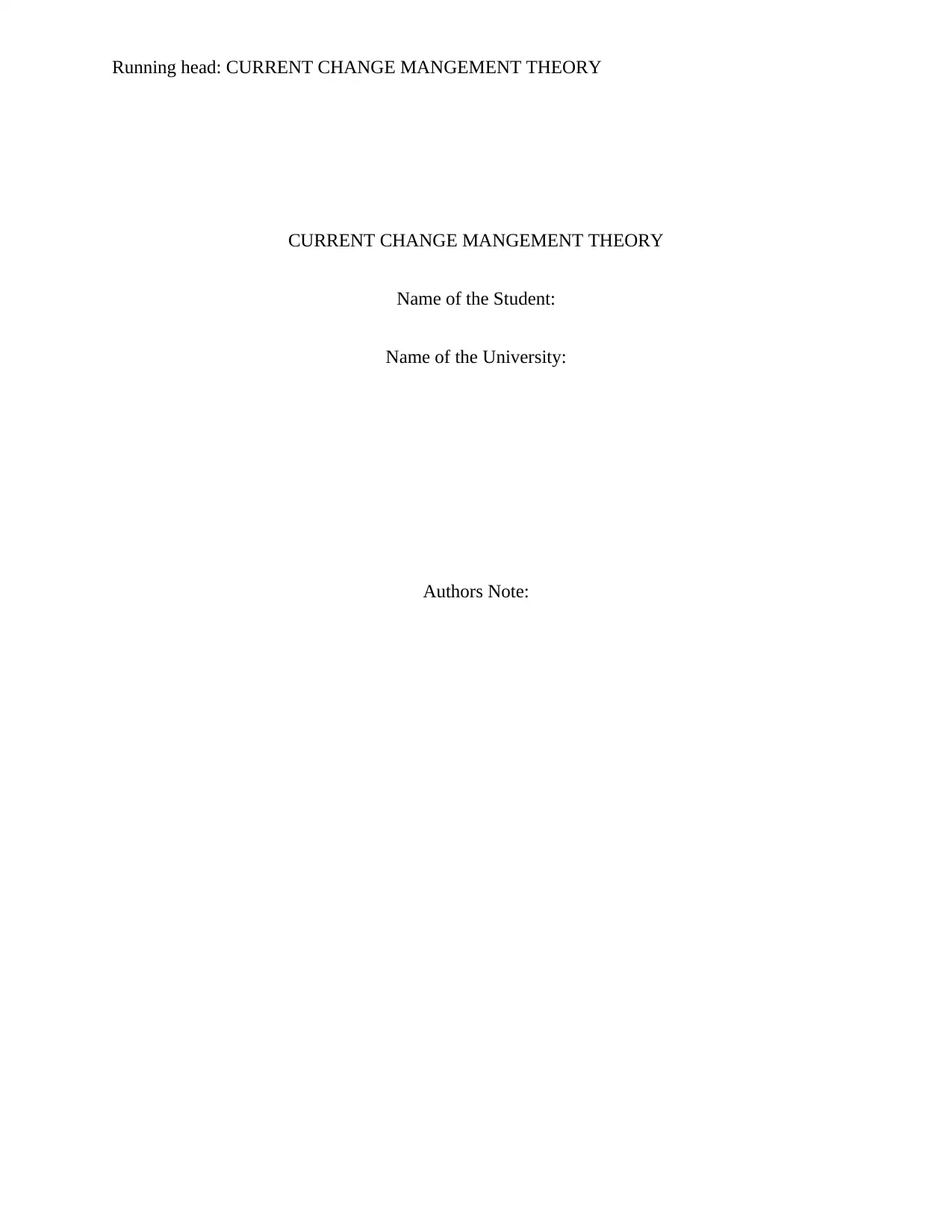
Running head: CURRENT CHANGE MANGEMENT THEORY
CURRENT CHANGE MANGEMENT THEORY
Name of the Student:
Name of the University:
Authors Note:
CURRENT CHANGE MANGEMENT THEORY
Name of the Student:
Name of the University:
Authors Note:
Paraphrase This Document
Need a fresh take? Get an instant paraphrase of this document with our AI Paraphraser
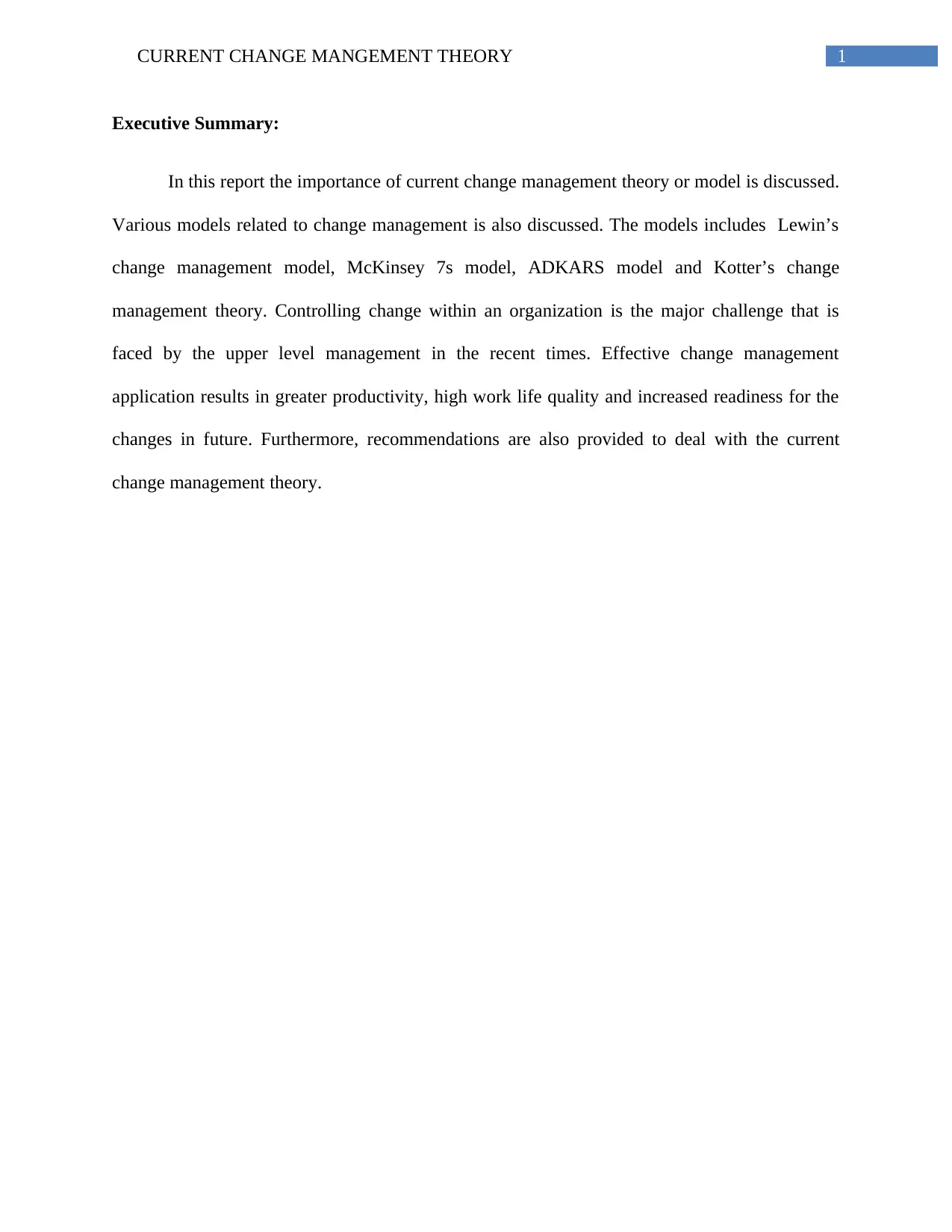
1CURRENT CHANGE MANGEMENT THEORY
Executive Summary:
In this report the importance of current change management theory or model is discussed.
Various models related to change management is also discussed. The models includes Lewin’s
change management model, McKinsey 7s model, ADKARS model and Kotter’s change
management theory. Controlling change within an organization is the major challenge that is
faced by the upper level management in the recent times. Effective change management
application results in greater productivity, high work life quality and increased readiness for the
changes in future. Furthermore, recommendations are also provided to deal with the current
change management theory.
Executive Summary:
In this report the importance of current change management theory or model is discussed.
Various models related to change management is also discussed. The models includes Lewin’s
change management model, McKinsey 7s model, ADKARS model and Kotter’s change
management theory. Controlling change within an organization is the major challenge that is
faced by the upper level management in the recent times. Effective change management
application results in greater productivity, high work life quality and increased readiness for the
changes in future. Furthermore, recommendations are also provided to deal with the current
change management theory.
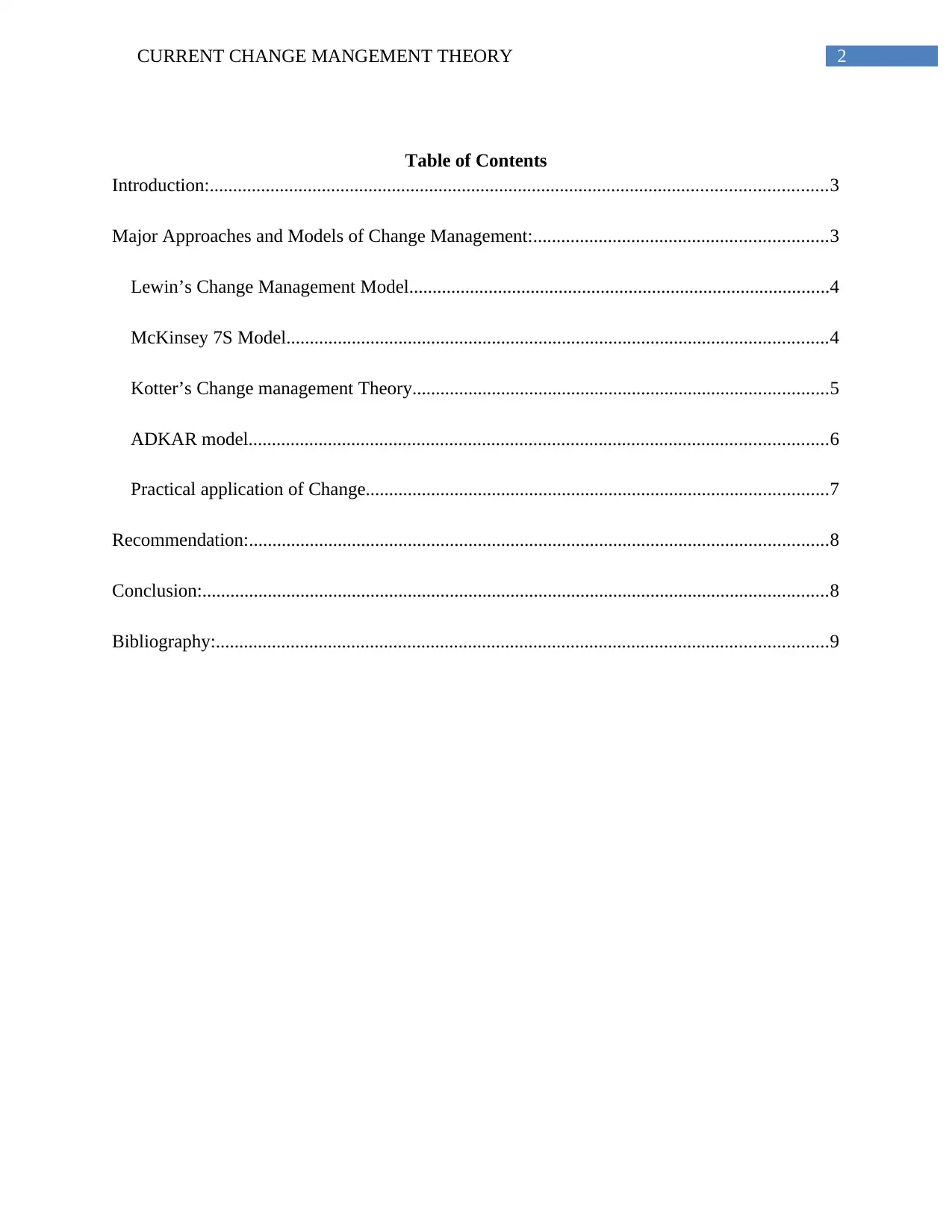
2CURRENT CHANGE MANGEMENT THEORY
Table of Contents
Introduction:....................................................................................................................................3
Major Approaches and Models of Change Management:...............................................................3
Lewin’s Change Management Model..........................................................................................4
McKinsey 7S Model....................................................................................................................4
Kotter’s Change management Theory.........................................................................................5
ADKAR model............................................................................................................................6
Practical application of Change...................................................................................................7
Recommendation:............................................................................................................................8
Conclusion:......................................................................................................................................8
Bibliography:...................................................................................................................................9
Table of Contents
Introduction:....................................................................................................................................3
Major Approaches and Models of Change Management:...............................................................3
Lewin’s Change Management Model..........................................................................................4
McKinsey 7S Model....................................................................................................................4
Kotter’s Change management Theory.........................................................................................5
ADKAR model............................................................................................................................6
Practical application of Change...................................................................................................7
Recommendation:............................................................................................................................8
Conclusion:......................................................................................................................................8
Bibliography:...................................................................................................................................9
⊘ This is a preview!⊘
Do you want full access?
Subscribe today to unlock all pages.

Trusted by 1+ million students worldwide
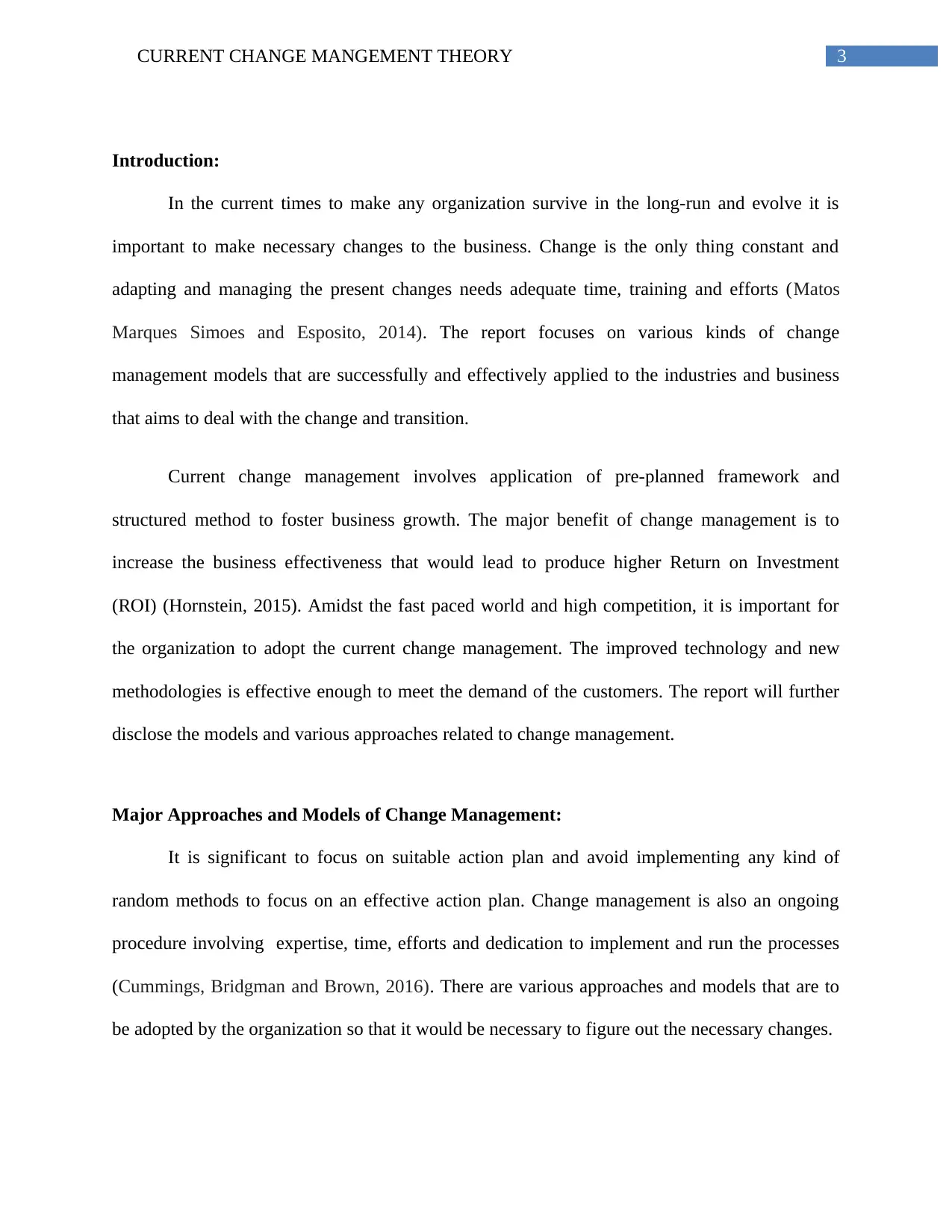
3CURRENT CHANGE MANGEMENT THEORY
Introduction:
In the current times to make any organization survive in the long-run and evolve it is
important to make necessary changes to the business. Change is the only thing constant and
adapting and managing the present changes needs adequate time, training and efforts (Matos
Marques Simoes and Esposito, 2014). The report focuses on various kinds of change
management models that are successfully and effectively applied to the industries and business
that aims to deal with the change and transition.
Current change management involves application of pre-planned framework and
structured method to foster business growth. The major benefit of change management is to
increase the business effectiveness that would lead to produce higher Return on Investment
(ROI) (Hornstein, 2015). Amidst the fast paced world and high competition, it is important for
the organization to adopt the current change management. The improved technology and new
methodologies is effective enough to meet the demand of the customers. The report will further
disclose the models and various approaches related to change management.
Major Approaches and Models of Change Management:
It is significant to focus on suitable action plan and avoid implementing any kind of
random methods to focus on an effective action plan. Change management is also an ongoing
procedure involving expertise, time, efforts and dedication to implement and run the processes
(Cummings, Bridgman and Brown, 2016). There are various approaches and models that are to
be adopted by the organization so that it would be necessary to figure out the necessary changes.
Introduction:
In the current times to make any organization survive in the long-run and evolve it is
important to make necessary changes to the business. Change is the only thing constant and
adapting and managing the present changes needs adequate time, training and efforts (Matos
Marques Simoes and Esposito, 2014). The report focuses on various kinds of change
management models that are successfully and effectively applied to the industries and business
that aims to deal with the change and transition.
Current change management involves application of pre-planned framework and
structured method to foster business growth. The major benefit of change management is to
increase the business effectiveness that would lead to produce higher Return on Investment
(ROI) (Hornstein, 2015). Amidst the fast paced world and high competition, it is important for
the organization to adopt the current change management. The improved technology and new
methodologies is effective enough to meet the demand of the customers. The report will further
disclose the models and various approaches related to change management.
Major Approaches and Models of Change Management:
It is significant to focus on suitable action plan and avoid implementing any kind of
random methods to focus on an effective action plan. Change management is also an ongoing
procedure involving expertise, time, efforts and dedication to implement and run the processes
(Cummings, Bridgman and Brown, 2016). There are various approaches and models that are to
be adopted by the organization so that it would be necessary to figure out the necessary changes.
Paraphrase This Document
Need a fresh take? Get an instant paraphrase of this document with our AI Paraphraser
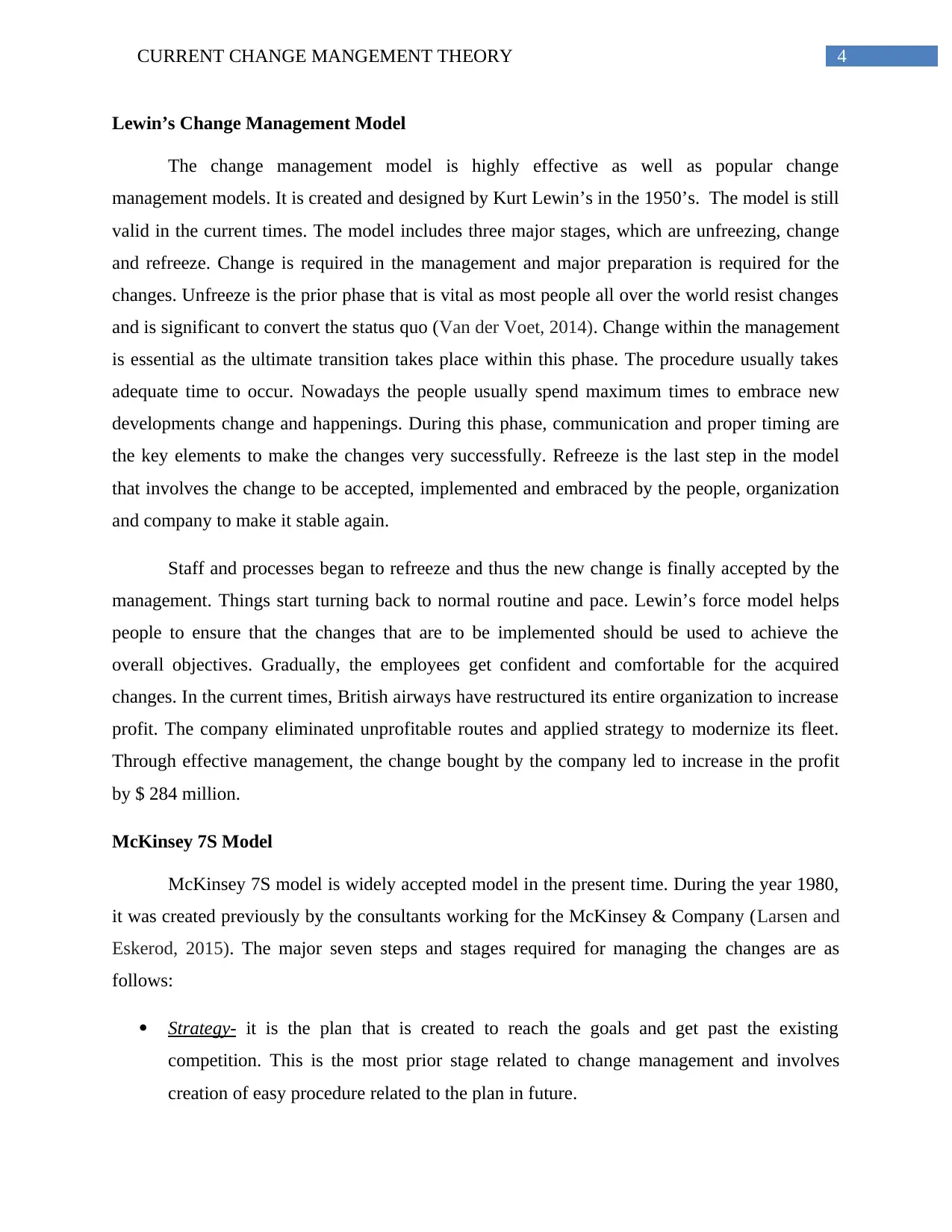
4CURRENT CHANGE MANGEMENT THEORY
Lewin’s Change Management Model
The change management model is highly effective as well as popular change
management models. It is created and designed by Kurt Lewin’s in the 1950’s. The model is still
valid in the current times. The model includes three major stages, which are unfreezing, change
and refreeze. Change is required in the management and major preparation is required for the
changes. Unfreeze is the prior phase that is vital as most people all over the world resist changes
and is significant to convert the status quo (Van der Voet, 2014). Change within the management
is essential as the ultimate transition takes place within this phase. The procedure usually takes
adequate time to occur. Nowadays the people usually spend maximum times to embrace new
developments change and happenings. During this phase, communication and proper timing are
the key elements to make the changes very successfully. Refreeze is the last step in the model
that involves the change to be accepted, implemented and embraced by the people, organization
and company to make it stable again.
Staff and processes began to refreeze and thus the new change is finally accepted by the
management. Things start turning back to normal routine and pace. Lewin’s force model helps
people to ensure that the changes that are to be implemented should be used to achieve the
overall objectives. Gradually, the employees get confident and comfortable for the acquired
changes. In the current times, British airways have restructured its entire organization to increase
profit. The company eliminated unprofitable routes and applied strategy to modernize its fleet.
Through effective management, the change bought by the company led to increase in the profit
by $ 284 million.
McKinsey 7S Model
McKinsey 7S model is widely accepted model in the present time. During the year 1980,
it was created previously by the consultants working for the McKinsey & Company (Larsen and
Eskerod, 2015). The major seven steps and stages required for managing the changes are as
follows:
Strategy- it is the plan that is created to reach the goals and get past the existing
competition. This is the most prior stage related to change management and involves
creation of easy procedure related to the plan in future.
Lewin’s Change Management Model
The change management model is highly effective as well as popular change
management models. It is created and designed by Kurt Lewin’s in the 1950’s. The model is still
valid in the current times. The model includes three major stages, which are unfreezing, change
and refreeze. Change is required in the management and major preparation is required for the
changes. Unfreeze is the prior phase that is vital as most people all over the world resist changes
and is significant to convert the status quo (Van der Voet, 2014). Change within the management
is essential as the ultimate transition takes place within this phase. The procedure usually takes
adequate time to occur. Nowadays the people usually spend maximum times to embrace new
developments change and happenings. During this phase, communication and proper timing are
the key elements to make the changes very successfully. Refreeze is the last step in the model
that involves the change to be accepted, implemented and embraced by the people, organization
and company to make it stable again.
Staff and processes began to refreeze and thus the new change is finally accepted by the
management. Things start turning back to normal routine and pace. Lewin’s force model helps
people to ensure that the changes that are to be implemented should be used to achieve the
overall objectives. Gradually, the employees get confident and comfortable for the acquired
changes. In the current times, British airways have restructured its entire organization to increase
profit. The company eliminated unprofitable routes and applied strategy to modernize its fleet.
Through effective management, the change bought by the company led to increase in the profit
by $ 284 million.
McKinsey 7S Model
McKinsey 7S model is widely accepted model in the present time. During the year 1980,
it was created previously by the consultants working for the McKinsey & Company (Larsen and
Eskerod, 2015). The major seven steps and stages required for managing the changes are as
follows:
Strategy- it is the plan that is created to reach the goals and get past the existing
competition. This is the most prior stage related to change management and involves
creation of easy procedure related to the plan in future.
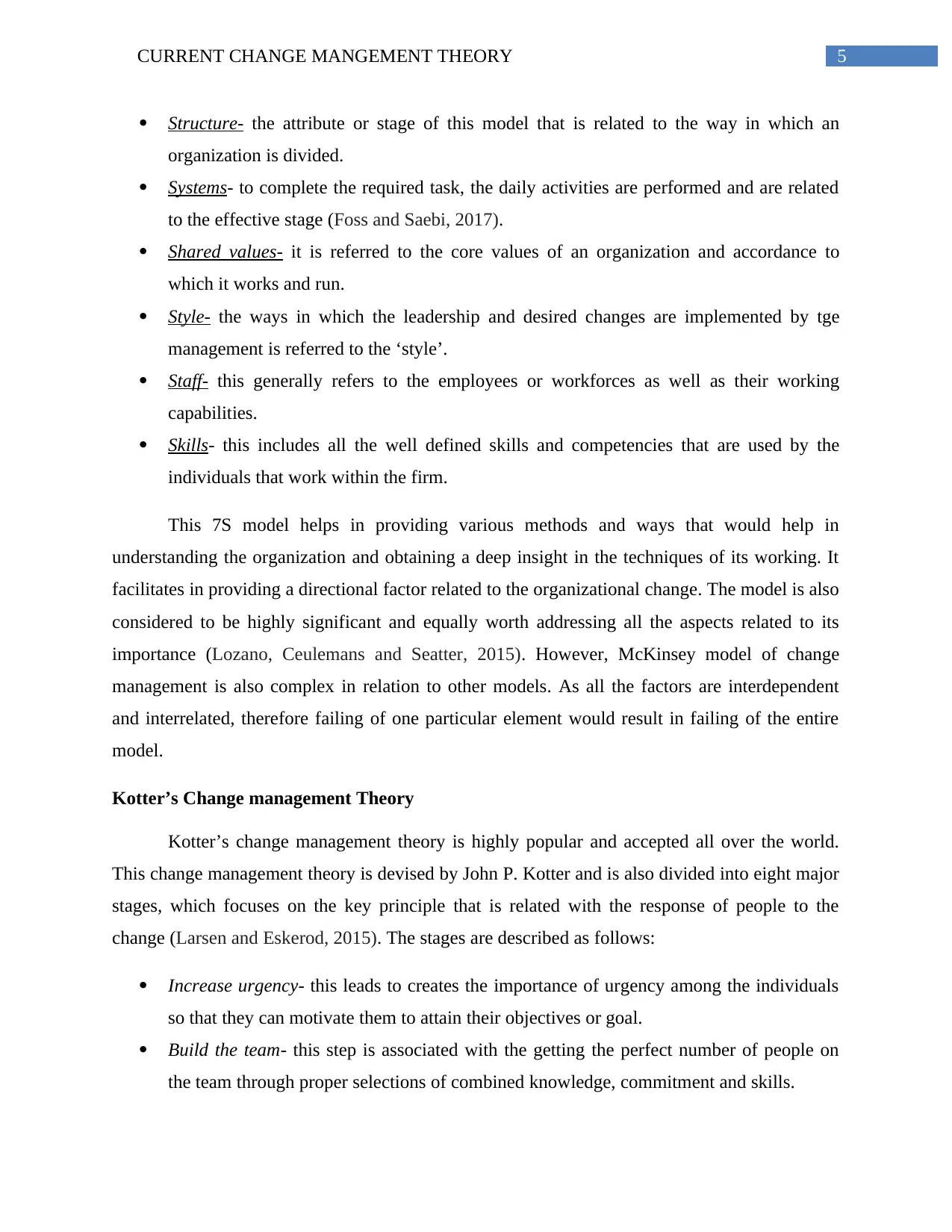
5CURRENT CHANGE MANGEMENT THEORY
Structure- the attribute or stage of this model that is related to the way in which an
organization is divided.
Systems- to complete the required task, the daily activities are performed and are related
to the effective stage (Foss and Saebi, 2017).
Shared values- it is referred to the core values of an organization and accordance to
which it works and run.
Style- the ways in which the leadership and desired changes are implemented by tge
management is referred to the ‘style’.
Staff- this generally refers to the employees or workforces as well as their working
capabilities.
Skills- this includes all the well defined skills and competencies that are used by the
individuals that work within the firm.
This 7S model helps in providing various methods and ways that would help in
understanding the organization and obtaining a deep insight in the techniques of its working. It
facilitates in providing a directional factor related to the organizational change. The model is also
considered to be highly significant and equally worth addressing all the aspects related to its
importance (Lozano, Ceulemans and Seatter, 2015). However, McKinsey model of change
management is also complex in relation to other models. As all the factors are interdependent
and interrelated, therefore failing of one particular element would result in failing of the entire
model.
Kotter’s Change management Theory
Kotter’s change management theory is highly popular and accepted all over the world.
This change management theory is devised by John P. Kotter and is also divided into eight major
stages, which focuses on the key principle that is related with the response of people to the
change (Larsen and Eskerod, 2015). The stages are described as follows:
Increase urgency- this leads to creates the importance of urgency among the individuals
so that they can motivate them to attain their objectives or goal.
Build the team- this step is associated with the getting the perfect number of people on
the team through proper selections of combined knowledge, commitment and skills.
Structure- the attribute or stage of this model that is related to the way in which an
organization is divided.
Systems- to complete the required task, the daily activities are performed and are related
to the effective stage (Foss and Saebi, 2017).
Shared values- it is referred to the core values of an organization and accordance to
which it works and run.
Style- the ways in which the leadership and desired changes are implemented by tge
management is referred to the ‘style’.
Staff- this generally refers to the employees or workforces as well as their working
capabilities.
Skills- this includes all the well defined skills and competencies that are used by the
individuals that work within the firm.
This 7S model helps in providing various methods and ways that would help in
understanding the organization and obtaining a deep insight in the techniques of its working. It
facilitates in providing a directional factor related to the organizational change. The model is also
considered to be highly significant and equally worth addressing all the aspects related to its
importance (Lozano, Ceulemans and Seatter, 2015). However, McKinsey model of change
management is also complex in relation to other models. As all the factors are interdependent
and interrelated, therefore failing of one particular element would result in failing of the entire
model.
Kotter’s Change management Theory
Kotter’s change management theory is highly popular and accepted all over the world.
This change management theory is devised by John P. Kotter and is also divided into eight major
stages, which focuses on the key principle that is related with the response of people to the
change (Larsen and Eskerod, 2015). The stages are described as follows:
Increase urgency- this leads to creates the importance of urgency among the individuals
so that they can motivate them to attain their objectives or goal.
Build the team- this step is associated with the getting the perfect number of people on
the team through proper selections of combined knowledge, commitment and skills.
⊘ This is a preview!⊘
Do you want full access?
Subscribe today to unlock all pages.

Trusted by 1+ million students worldwide
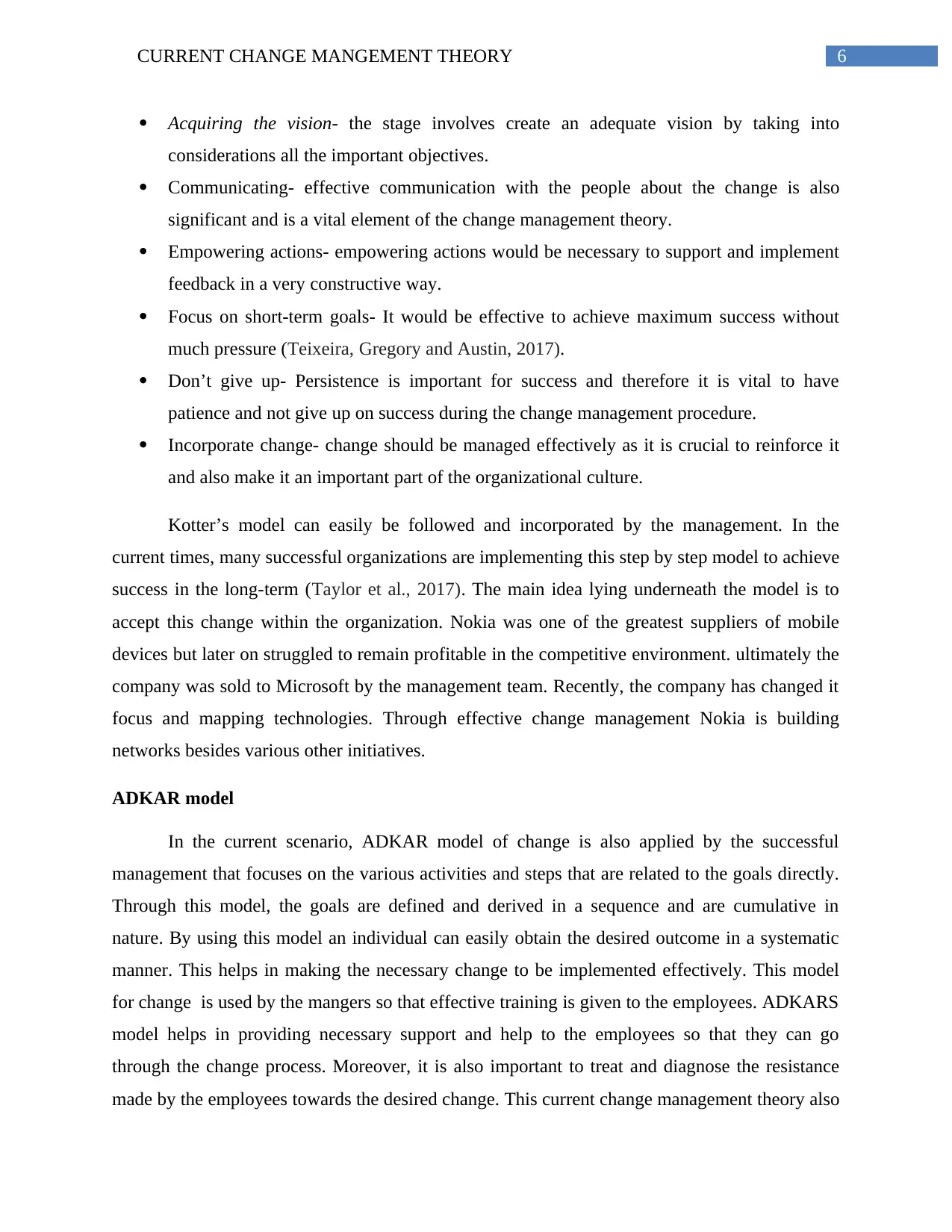
6CURRENT CHANGE MANGEMENT THEORY
Acquiring the vision- the stage involves create an adequate vision by taking into
considerations all the important objectives.
Communicating- effective communication with the people about the change is also
significant and is a vital element of the change management theory.
Empowering actions- empowering actions would be necessary to support and implement
feedback in a very constructive way.
Focus on short-term goals- It would be effective to achieve maximum success without
much pressure (Teixeira, Gregory and Austin, 2017).
Don’t give up- Persistence is important for success and therefore it is vital to have
patience and not give up on success during the change management procedure.
Incorporate change- change should be managed effectively as it is crucial to reinforce it
and also make it an important part of the organizational culture.
Kotter’s model can easily be followed and incorporated by the management. In the
current times, many successful organizations are implementing this step by step model to achieve
success in the long-term (Taylor et al., 2017). The main idea lying underneath the model is to
accept this change within the organization. Nokia was one of the greatest suppliers of mobile
devices but later on struggled to remain profitable in the competitive environment. ultimately the
company was sold to Microsoft by the management team. Recently, the company has changed it
focus and mapping technologies. Through effective change management Nokia is building
networks besides various other initiatives.
ADKAR model
In the current scenario, ADKAR model of change is also applied by the successful
management that focuses on the various activities and steps that are related to the goals directly.
Through this model, the goals are defined and derived in a sequence and are cumulative in
nature. By using this model an individual can easily obtain the desired outcome in a systematic
manner. This helps in making the necessary change to be implemented effectively. This model
for change is used by the mangers so that effective training is given to the employees. ADKARS
model helps in providing necessary support and help to the employees so that they can go
through the change process. Moreover, it is also important to treat and diagnose the resistance
made by the employees towards the desired change. This current change management theory also
Acquiring the vision- the stage involves create an adequate vision by taking into
considerations all the important objectives.
Communicating- effective communication with the people about the change is also
significant and is a vital element of the change management theory.
Empowering actions- empowering actions would be necessary to support and implement
feedback in a very constructive way.
Focus on short-term goals- It would be effective to achieve maximum success without
much pressure (Teixeira, Gregory and Austin, 2017).
Don’t give up- Persistence is important for success and therefore it is vital to have
patience and not give up on success during the change management procedure.
Incorporate change- change should be managed effectively as it is crucial to reinforce it
and also make it an important part of the organizational culture.
Kotter’s model can easily be followed and incorporated by the management. In the
current times, many successful organizations are implementing this step by step model to achieve
success in the long-term (Taylor et al., 2017). The main idea lying underneath the model is to
accept this change within the organization. Nokia was one of the greatest suppliers of mobile
devices but later on struggled to remain profitable in the competitive environment. ultimately the
company was sold to Microsoft by the management team. Recently, the company has changed it
focus and mapping technologies. Through effective change management Nokia is building
networks besides various other initiatives.
ADKAR model
In the current scenario, ADKAR model of change is also applied by the successful
management that focuses on the various activities and steps that are related to the goals directly.
Through this model, the goals are defined and derived in a sequence and are cumulative in
nature. By using this model an individual can easily obtain the desired outcome in a systematic
manner. This helps in making the necessary change to be implemented effectively. This model
for change is used by the mangers so that effective training is given to the employees. ADKARS
model helps in providing necessary support and help to the employees so that they can go
through the change process. Moreover, it is also important to treat and diagnose the resistance
made by the employees towards the desired change. This current change management theory also
Paraphrase This Document
Need a fresh take? Get an instant paraphrase of this document with our AI Paraphraser
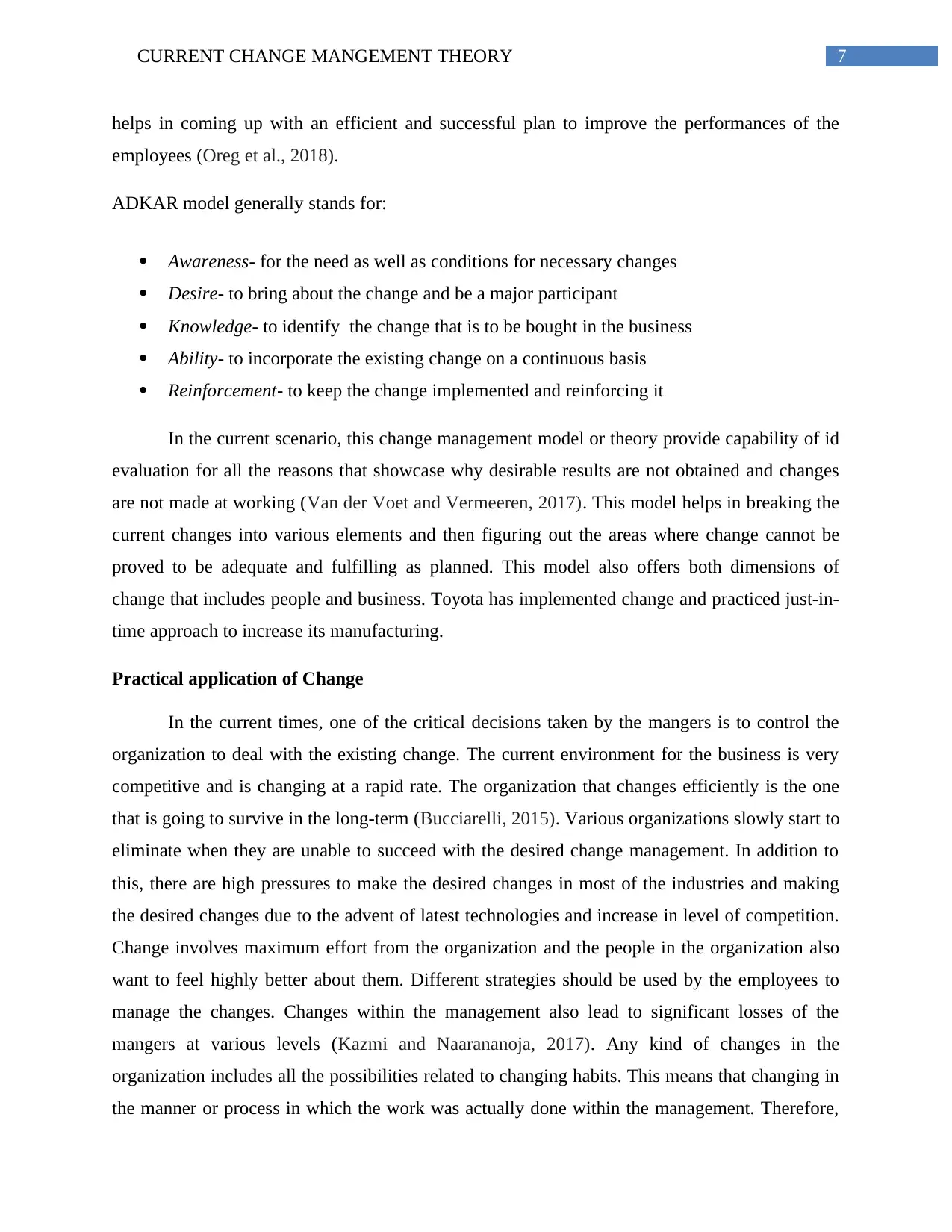
7CURRENT CHANGE MANGEMENT THEORY
helps in coming up with an efficient and successful plan to improve the performances of the
employees (Oreg et al., 2018).
ADKAR model generally stands for:
Awareness- for the need as well as conditions for necessary changes
Desire- to bring about the change and be a major participant
Knowledge- to identify the change that is to be bought in the business
Ability- to incorporate the existing change on a continuous basis
Reinforcement- to keep the change implemented and reinforcing it
In the current scenario, this change management model or theory provide capability of id
evaluation for all the reasons that showcase why desirable results are not obtained and changes
are not made at working (Van der Voet and Vermeeren, 2017). This model helps in breaking the
current changes into various elements and then figuring out the areas where change cannot be
proved to be adequate and fulfilling as planned. This model also offers both dimensions of
change that includes people and business. Toyota has implemented change and practiced just-in-
time approach to increase its manufacturing.
Practical application of Change
In the current times, one of the critical decisions taken by the mangers is to control the
organization to deal with the existing change. The current environment for the business is very
competitive and is changing at a rapid rate. The organization that changes efficiently is the one
that is going to survive in the long-term (Bucciarelli, 2015). Various organizations slowly start to
eliminate when they are unable to succeed with the desired change management. In addition to
this, there are high pressures to make the desired changes in most of the industries and making
the desired changes due to the advent of latest technologies and increase in level of competition.
Change involves maximum effort from the organization and the people in the organization also
want to feel highly better about them. Different strategies should be used by the employees to
manage the changes. Changes within the management also lead to significant losses of the
mangers at various levels (Kazmi and Naarananoja, 2017). Any kind of changes in the
organization includes all the possibilities related to changing habits. This means that changing in
the manner or process in which the work was actually done within the management. Therefore,
helps in coming up with an efficient and successful plan to improve the performances of the
employees (Oreg et al., 2018).
ADKAR model generally stands for:
Awareness- for the need as well as conditions for necessary changes
Desire- to bring about the change and be a major participant
Knowledge- to identify the change that is to be bought in the business
Ability- to incorporate the existing change on a continuous basis
Reinforcement- to keep the change implemented and reinforcing it
In the current scenario, this change management model or theory provide capability of id
evaluation for all the reasons that showcase why desirable results are not obtained and changes
are not made at working (Van der Voet and Vermeeren, 2017). This model helps in breaking the
current changes into various elements and then figuring out the areas where change cannot be
proved to be adequate and fulfilling as planned. This model also offers both dimensions of
change that includes people and business. Toyota has implemented change and practiced just-in-
time approach to increase its manufacturing.
Practical application of Change
In the current times, one of the critical decisions taken by the mangers is to control the
organization to deal with the existing change. The current environment for the business is very
competitive and is changing at a rapid rate. The organization that changes efficiently is the one
that is going to survive in the long-term (Bucciarelli, 2015). Various organizations slowly start to
eliminate when they are unable to succeed with the desired change management. In addition to
this, there are high pressures to make the desired changes in most of the industries and making
the desired changes due to the advent of latest technologies and increase in level of competition.
Change involves maximum effort from the organization and the people in the organization also
want to feel highly better about them. Different strategies should be used by the employees to
manage the changes. Changes within the management also lead to significant losses of the
mangers at various levels (Kazmi and Naarananoja, 2017). Any kind of changes in the
organization includes all the possibilities related to changing habits. This means that changing in
the manner or process in which the work was actually done within the management. Therefore,
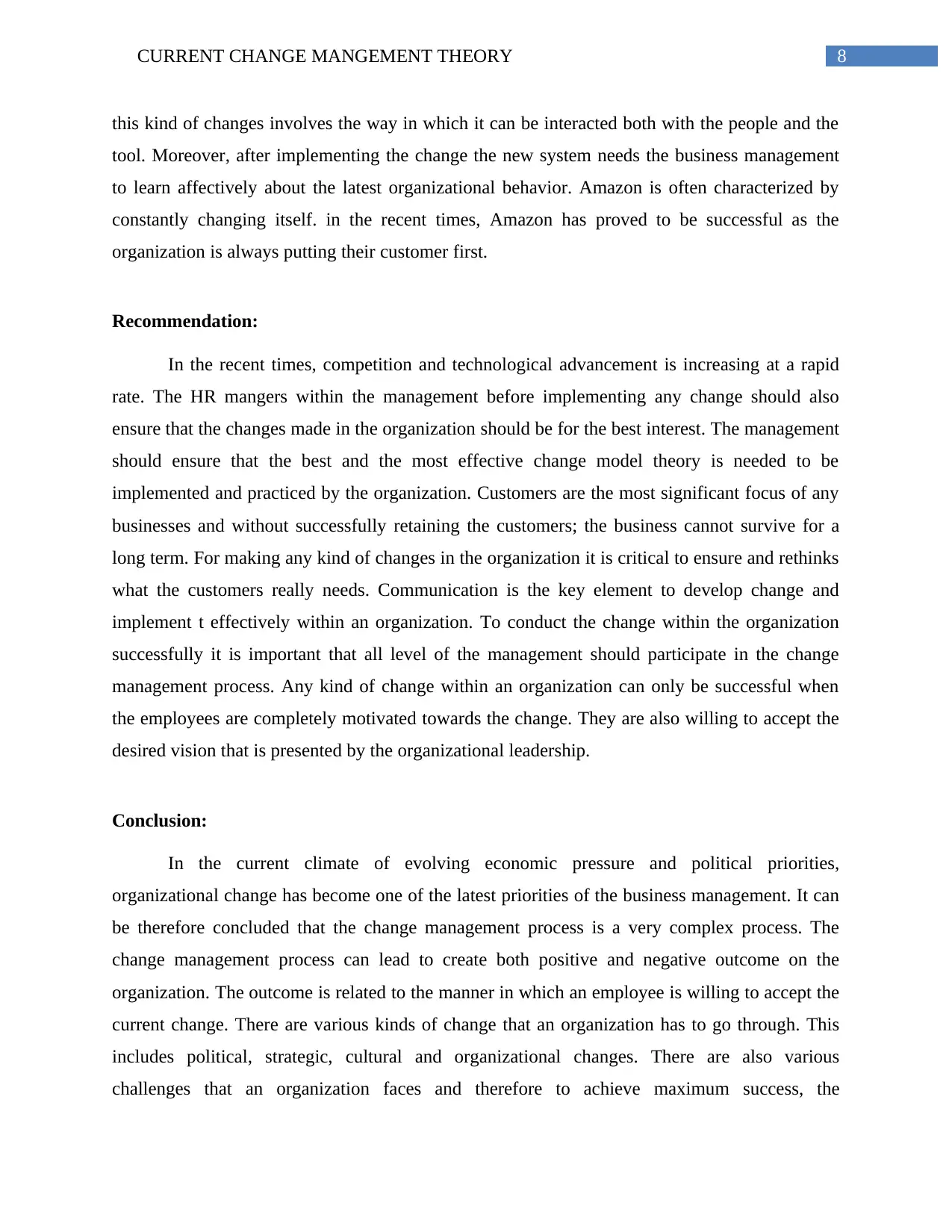
8CURRENT CHANGE MANGEMENT THEORY
this kind of changes involves the way in which it can be interacted both with the people and the
tool. Moreover, after implementing the change the new system needs the business management
to learn affectively about the latest organizational behavior. Amazon is often characterized by
constantly changing itself. in the recent times, Amazon has proved to be successful as the
organization is always putting their customer first.
Recommendation:
In the recent times, competition and technological advancement is increasing at a rapid
rate. The HR mangers within the management before implementing any change should also
ensure that the changes made in the organization should be for the best interest. The management
should ensure that the best and the most effective change model theory is needed to be
implemented and practiced by the organization. Customers are the most significant focus of any
businesses and without successfully retaining the customers; the business cannot survive for a
long term. For making any kind of changes in the organization it is critical to ensure and rethinks
what the customers really needs. Communication is the key element to develop change and
implement t effectively within an organization. To conduct the change within the organization
successfully it is important that all level of the management should participate in the change
management process. Any kind of change within an organization can only be successful when
the employees are completely motivated towards the change. They are also willing to accept the
desired vision that is presented by the organizational leadership.
Conclusion:
In the current climate of evolving economic pressure and political priorities,
organizational change has become one of the latest priorities of the business management. It can
be therefore concluded that the change management process is a very complex process. The
change management process can lead to create both positive and negative outcome on the
organization. The outcome is related to the manner in which an employee is willing to accept the
current change. There are various kinds of change that an organization has to go through. This
includes political, strategic, cultural and organizational changes. There are also various
challenges that an organization faces and therefore to achieve maximum success, the
this kind of changes involves the way in which it can be interacted both with the people and the
tool. Moreover, after implementing the change the new system needs the business management
to learn affectively about the latest organizational behavior. Amazon is often characterized by
constantly changing itself. in the recent times, Amazon has proved to be successful as the
organization is always putting their customer first.
Recommendation:
In the recent times, competition and technological advancement is increasing at a rapid
rate. The HR mangers within the management before implementing any change should also
ensure that the changes made in the organization should be for the best interest. The management
should ensure that the best and the most effective change model theory is needed to be
implemented and practiced by the organization. Customers are the most significant focus of any
businesses and without successfully retaining the customers; the business cannot survive for a
long term. For making any kind of changes in the organization it is critical to ensure and rethinks
what the customers really needs. Communication is the key element to develop change and
implement t effectively within an organization. To conduct the change within the organization
successfully it is important that all level of the management should participate in the change
management process. Any kind of change within an organization can only be successful when
the employees are completely motivated towards the change. They are also willing to accept the
desired vision that is presented by the organizational leadership.
Conclusion:
In the current climate of evolving economic pressure and political priorities,
organizational change has become one of the latest priorities of the business management. It can
be therefore concluded that the change management process is a very complex process. The
change management process can lead to create both positive and negative outcome on the
organization. The outcome is related to the manner in which an employee is willing to accept the
current change. There are various kinds of change that an organization has to go through. This
includes political, strategic, cultural and organizational changes. There are also various
challenges that an organization faces and therefore to achieve maximum success, the
⊘ This is a preview!⊘
Do you want full access?
Subscribe today to unlock all pages.

Trusted by 1+ million students worldwide
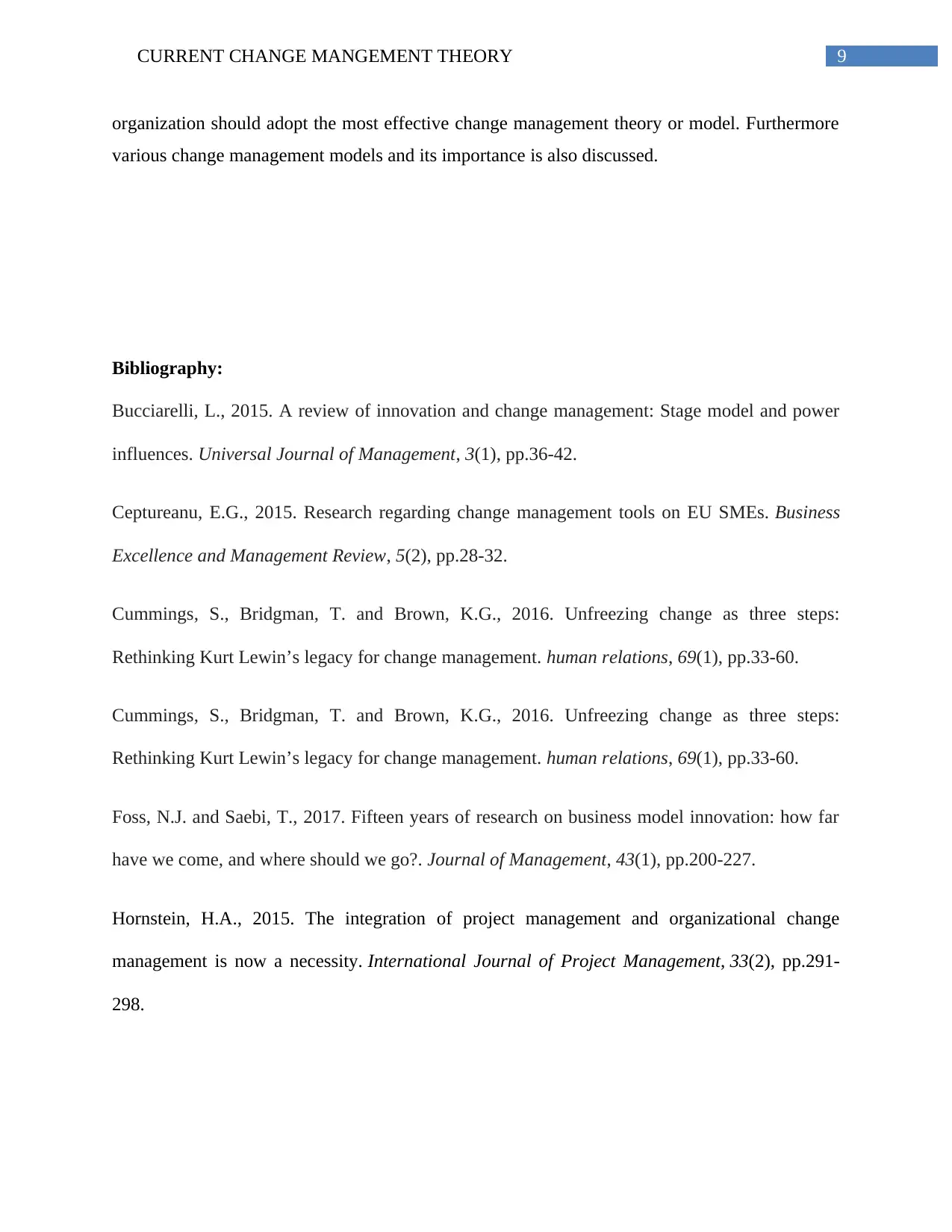
9CURRENT CHANGE MANGEMENT THEORY
organization should adopt the most effective change management theory or model. Furthermore
various change management models and its importance is also discussed.
Bibliography:
Bucciarelli, L., 2015. A review of innovation and change management: Stage model and power
influences. Universal Journal of Management, 3(1), pp.36-42.
Ceptureanu, E.G., 2015. Research regarding change management tools on EU SMEs. Business
Excellence and Management Review, 5(2), pp.28-32.
Cummings, S., Bridgman, T. and Brown, K.G., 2016. Unfreezing change as three steps:
Rethinking Kurt Lewin’s legacy for change management. human relations, 69(1), pp.33-60.
Cummings, S., Bridgman, T. and Brown, K.G., 2016. Unfreezing change as three steps:
Rethinking Kurt Lewin’s legacy for change management. human relations, 69(1), pp.33-60.
Foss, N.J. and Saebi, T., 2017. Fifteen years of research on business model innovation: how far
have we come, and where should we go?. Journal of Management, 43(1), pp.200-227.
Hornstein, H.A., 2015. The integration of project management and organizational change
management is now a necessity. International Journal of Project Management, 33(2), pp.291-
298.
organization should adopt the most effective change management theory or model. Furthermore
various change management models and its importance is also discussed.
Bibliography:
Bucciarelli, L., 2015. A review of innovation and change management: Stage model and power
influences. Universal Journal of Management, 3(1), pp.36-42.
Ceptureanu, E.G., 2015. Research regarding change management tools on EU SMEs. Business
Excellence and Management Review, 5(2), pp.28-32.
Cummings, S., Bridgman, T. and Brown, K.G., 2016. Unfreezing change as three steps:
Rethinking Kurt Lewin’s legacy for change management. human relations, 69(1), pp.33-60.
Cummings, S., Bridgman, T. and Brown, K.G., 2016. Unfreezing change as three steps:
Rethinking Kurt Lewin’s legacy for change management. human relations, 69(1), pp.33-60.
Foss, N.J. and Saebi, T., 2017. Fifteen years of research on business model innovation: how far
have we come, and where should we go?. Journal of Management, 43(1), pp.200-227.
Hornstein, H.A., 2015. The integration of project management and organizational change
management is now a necessity. International Journal of Project Management, 33(2), pp.291-
298.
Paraphrase This Document
Need a fresh take? Get an instant paraphrase of this document with our AI Paraphraser

10CURRENT CHANGE MANGEMENT THEORY
Kazmi, S.A.Z. and Naarananoja, M., 2017. Collection of Change Management Models–An
Opportunity to Make the Best Choice from the Various Organizational Transformational
Techniques. GSTF Journal on Business Review (GBR), 2(4).
Larsen, T. and Eskerod, P., 2015. Using Change Management Principles in Projects-An
Exploratory Case Study. Journal of Management & Change.
Lozano, R., Ceulemans, K. and Seatter, C.S., 2015. Teaching organisational change management
for sustainability: designing and delivering a course at the University of Leeds to better prepare
future sustainability change agents. Journal of Cleaner Production, 106, pp.205-215.
Matos Marques Simoes, P. and Esposito, M., 2014. Improving change management: How
communication nature influences resistance to change. Journal of Management
Development, 33(4), pp.324-341.
Oreg, S., Bartunek, J.M., Lee, G. and Do, B., 2018. An affect-based model of recipients’
responses to organizational change events. Academy of Management Review, 43(1), pp.65-86.
Taylor, S.G., Bedeian, A.G., Cole, M.S. and Zhang, Z., 2017. Developing and testing a dynamic
model of workplace incivility change. Journal of Management, 43(3), pp.645-670.
Teixeira, B., Gregory, P.A. and Austin, Z., 2017. How are pharmacists in Ontario adapting to
practice change? Results of a qualitative analysis using Kotter’s change management
model. Canadian Pharmacists Journal/Revue des Pharmaciens du Canada, 150(3), pp.198-205.
Van der Voet, J. and Vermeeren, B., 2017. Change management in hard times: can change
management mitigate the negative relationship between cutbacks and the organizational
Kazmi, S.A.Z. and Naarananoja, M., 2017. Collection of Change Management Models–An
Opportunity to Make the Best Choice from the Various Organizational Transformational
Techniques. GSTF Journal on Business Review (GBR), 2(4).
Larsen, T. and Eskerod, P., 2015. Using Change Management Principles in Projects-An
Exploratory Case Study. Journal of Management & Change.
Lozano, R., Ceulemans, K. and Seatter, C.S., 2015. Teaching organisational change management
for sustainability: designing and delivering a course at the University of Leeds to better prepare
future sustainability change agents. Journal of Cleaner Production, 106, pp.205-215.
Matos Marques Simoes, P. and Esposito, M., 2014. Improving change management: How
communication nature influences resistance to change. Journal of Management
Development, 33(4), pp.324-341.
Oreg, S., Bartunek, J.M., Lee, G. and Do, B., 2018. An affect-based model of recipients’
responses to organizational change events. Academy of Management Review, 43(1), pp.65-86.
Taylor, S.G., Bedeian, A.G., Cole, M.S. and Zhang, Z., 2017. Developing and testing a dynamic
model of workplace incivility change. Journal of Management, 43(3), pp.645-670.
Teixeira, B., Gregory, P.A. and Austin, Z., 2017. How are pharmacists in Ontario adapting to
practice change? Results of a qualitative analysis using Kotter’s change management
model. Canadian Pharmacists Journal/Revue des Pharmaciens du Canada, 150(3), pp.198-205.
Van der Voet, J. and Vermeeren, B., 2017. Change management in hard times: can change
management mitigate the negative relationship between cutbacks and the organizational
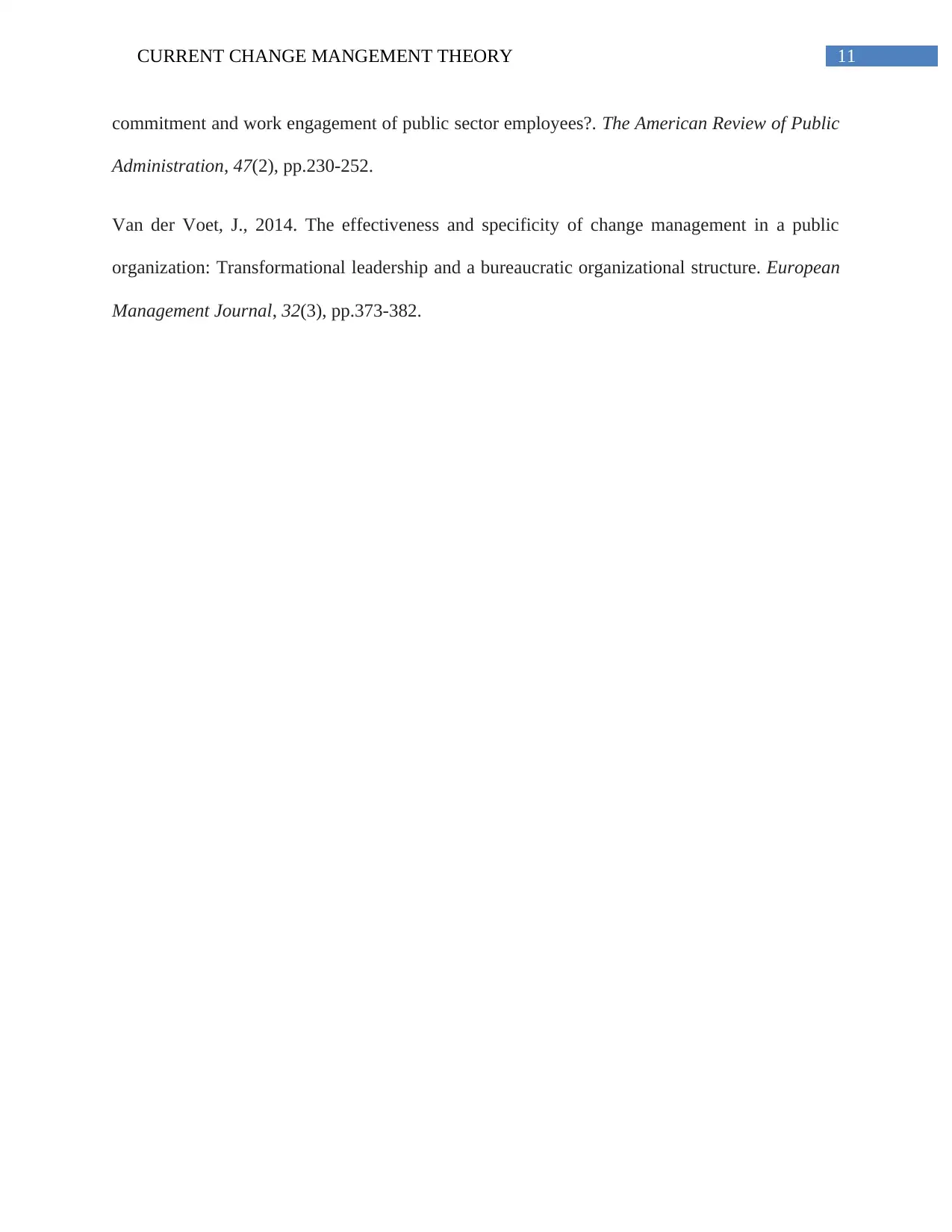
11CURRENT CHANGE MANGEMENT THEORY
commitment and work engagement of public sector employees?. The American Review of Public
Administration, 47(2), pp.230-252.
Van der Voet, J., 2014. The effectiveness and specificity of change management in a public
organization: Transformational leadership and a bureaucratic organizational structure. European
Management Journal, 32(3), pp.373-382.
commitment and work engagement of public sector employees?. The American Review of Public
Administration, 47(2), pp.230-252.
Van der Voet, J., 2014. The effectiveness and specificity of change management in a public
organization: Transformational leadership and a bureaucratic organizational structure. European
Management Journal, 32(3), pp.373-382.
⊘ This is a preview!⊘
Do you want full access?
Subscribe today to unlock all pages.

Trusted by 1+ million students worldwide
1 out of 12
Related Documents
Your All-in-One AI-Powered Toolkit for Academic Success.
+13062052269
info@desklib.com
Available 24*7 on WhatsApp / Email
![[object Object]](/_next/static/media/star-bottom.7253800d.svg)
Unlock your academic potential
© 2024 | Zucol Services PVT LTD | All rights reserved.





